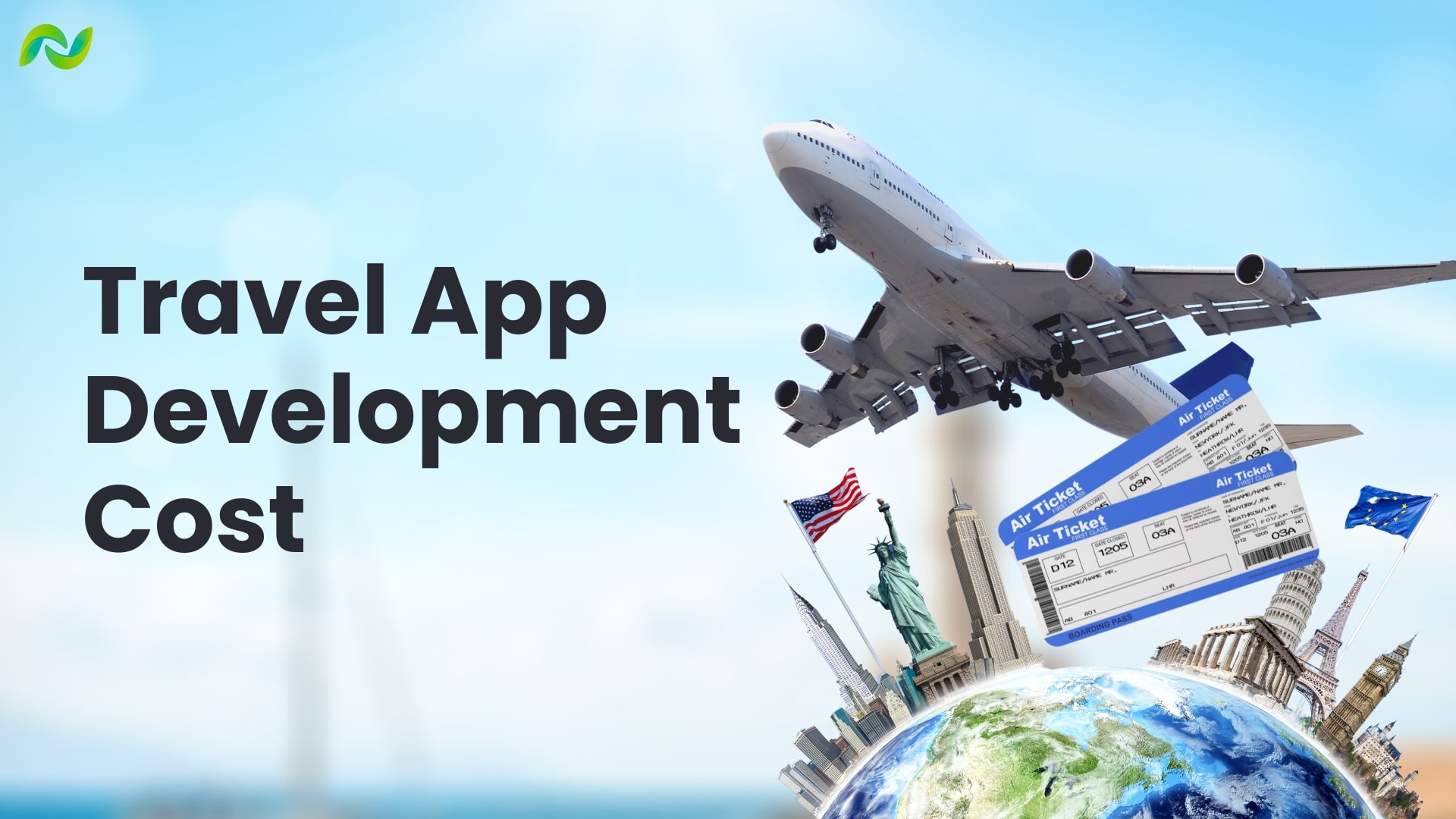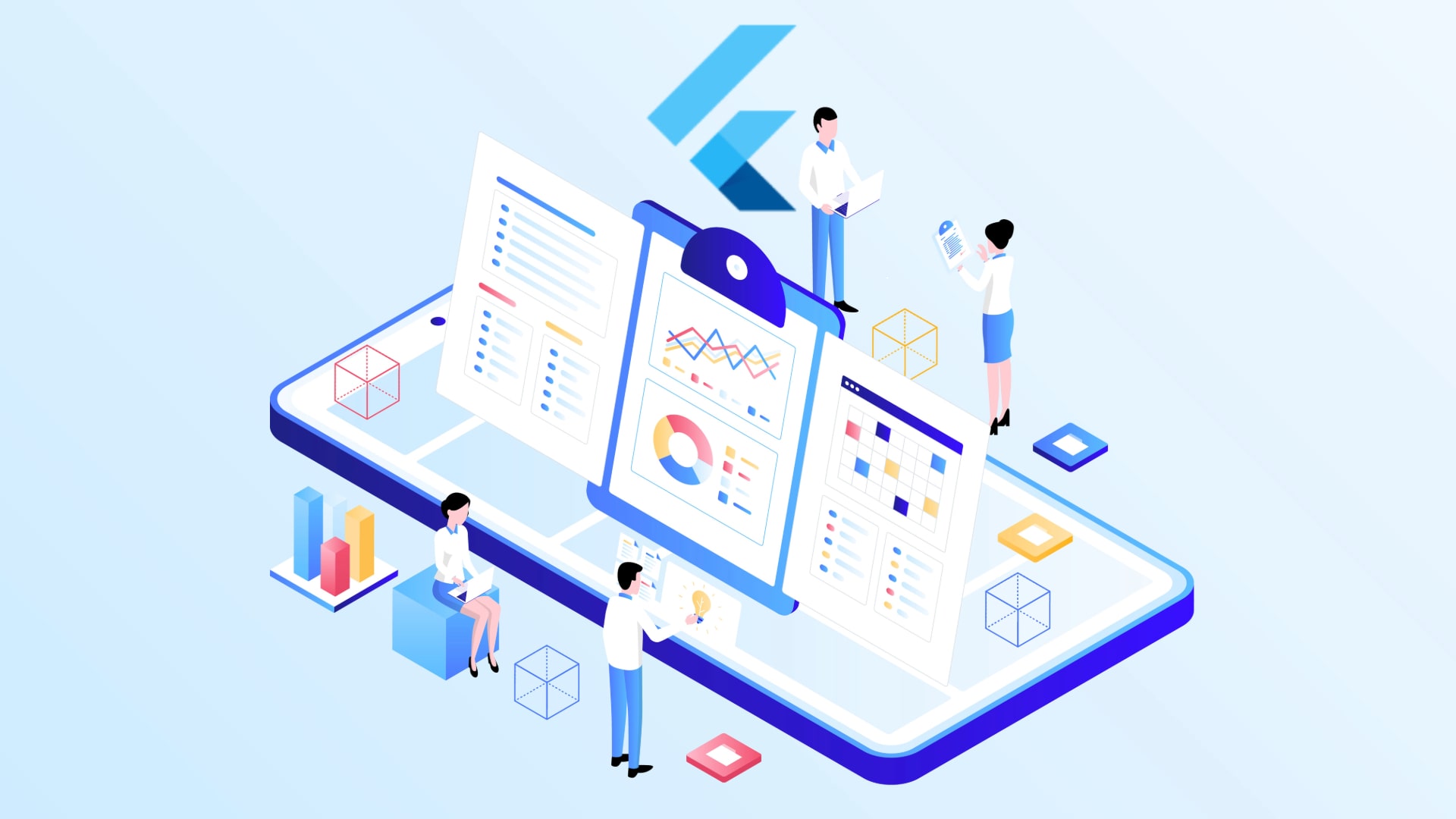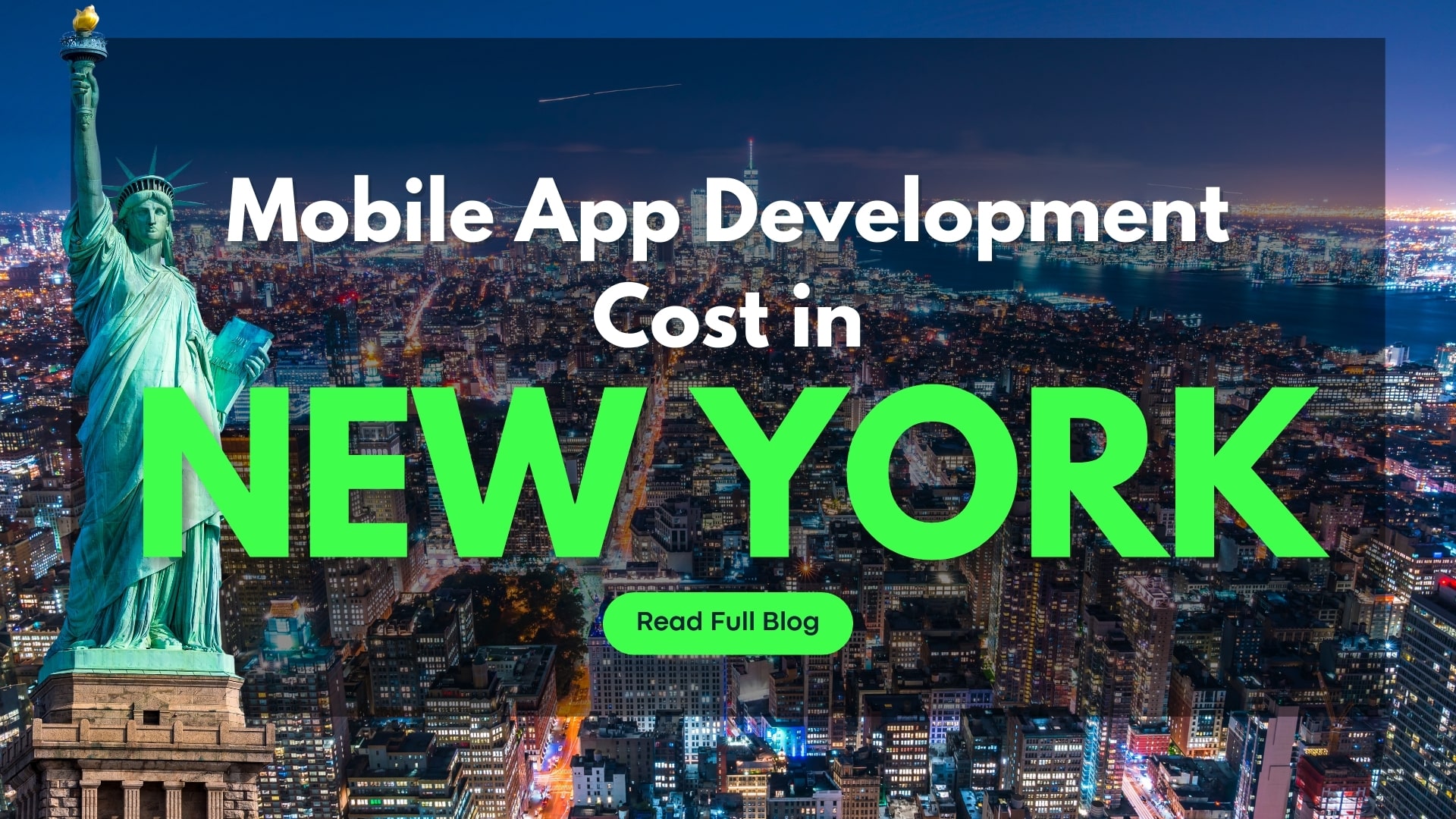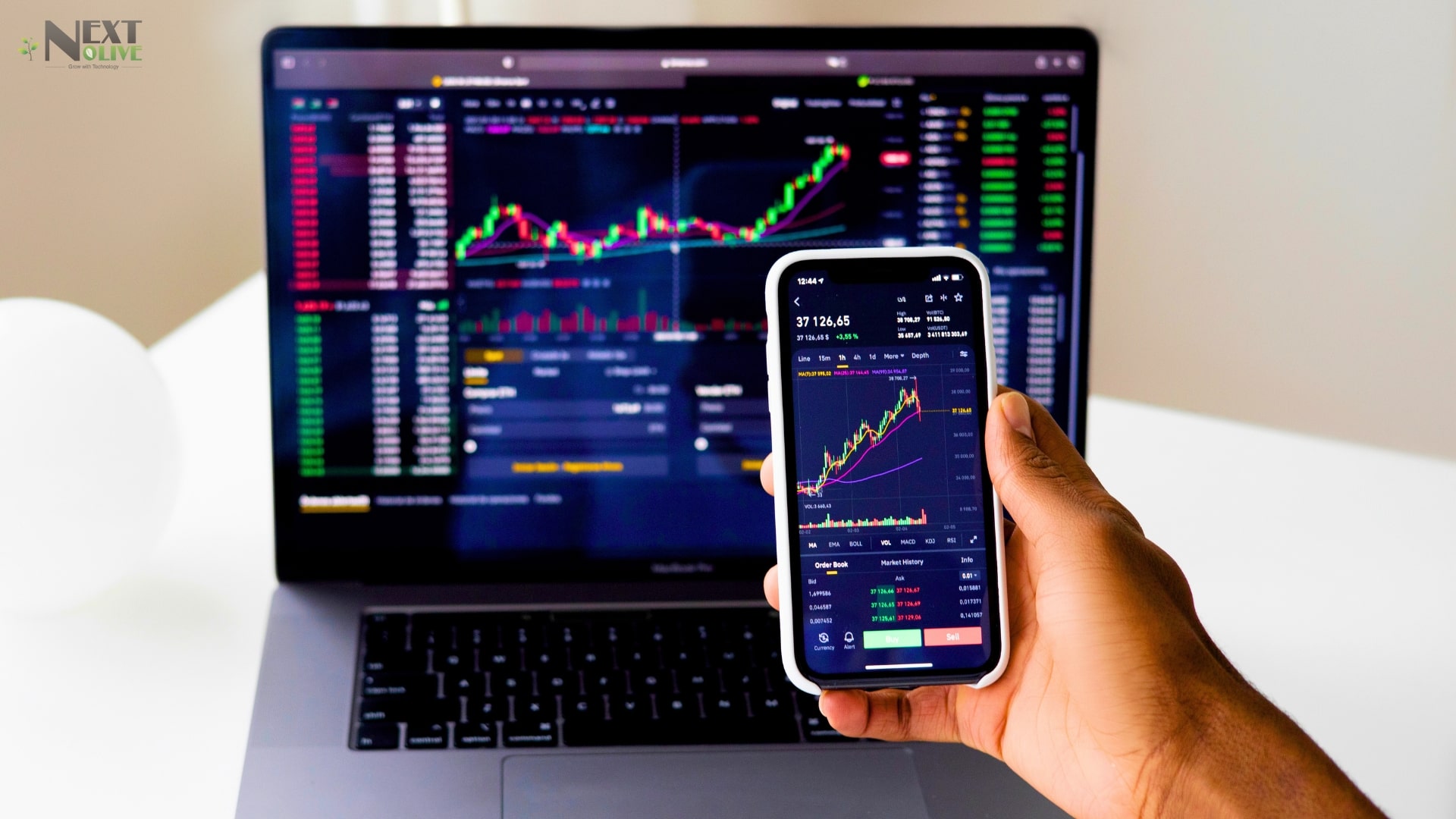How Much Does It Cost to Develop a Travel App?
In 2025, travel applications are becoming popular among people who seek convenience and cost-effective deals for planning a vacation or a trip. The travel app industry is growing fast, and many airline companies, hotel chains, etc, have joined the race, and new businesses are emerging to fill the gaps. If you are planning to launch your travel app, you should first know the details of travel booking app development costs. This guide will explore the various types of travel apps and key factors affecting travel app development costs.
Table of Contents
ToggleWhat is a Travel App?
A travel mobile app is a multi-feature tool that helps in simplifying and enhancing the user’s journey from start to end. This app is designed to assist the user with various aspects of traveling, such as booking a flight or hotel, organizing trips, finding the best deals, discovering local attractions, etc. The user can easily compare hotel prices or travel fares with just one click. Many travel applications offer navigation with maps, weather updates, restaurant recommendations based on your interests, etc. Travel apps also offer personalization by providing customized suggestions based on the user’s preferences. Travel apps make the user’s journey hassle-free and enhance the overall experience.
Difference Between a Travel App and a Travel Web App
- Integration With Devices:
- Mobile apps can easily access the device hardware, such as GPS, contacts, camera, and payment options, to offer a seamless user experience.
- Web apps do not have any access to the devices unless manually granted by the user to some extent.
- Level of Security:
- Mobile apps use blockchain and end-to-end encryption along with various types of security features, such as biometric login.
- Web apps might not have the same level of device and data security as compared to Apps, but It also Depends on Various Development Factors.
- Loyalty Programs and User Engagement:
- Travel apps offer various gamification features, loyalty points, and rewards to keep users engaged.
- Web apps also offer loyalty programs, but they do not have the same interactivity as mobile apps.
- Data Usage:
- Travel apps cache important resources and use them often, leading to lower data usage compared to web apps.
- Web apps often require new data to load and thus consume more data over time.
- Market Competition:
- Travel companies build their apps for a larger audience with numerous features to deliver the best user experience, making them more competitive in the market.
- Web apps often do not have the same level of competition because most users prefer apps over web apps.
- Convenience:
- Mobile apps have many functionalities, such as saved payment details, one-tap booking, and seamless checkouts, making travel planning easier.
- Web apps require users to enter details manually, which is frustrating for frequent travelers. Hence, they are less convenient.
- User Experience:
- Travel applications have better personalization features and user experience, along with various features such as navigation and booking.
- Travel web apps are generally less optimized for mobile users and offer a less engaging experience.
- Travel applications have better personalization features and user experience, along with various features such as navigation and booking.
- Performance and Speed:
- A mobile app is well optimized and faster as it uses locally stored data and cache to operate on any mobile device.
- Web app speed depends on internet speed and overall optimization to run on mobile devices. Generally, it is slower than apps.
- Offline Access:
- Travel apps allow users to access itineraries, bookings, etc., even without the internet due to caching.
- Web apps will not function without an internet connection.
- Push Notifications:
- Mobile applications send push notifications to keep users updated about their bookings and important alerts.
- Web apps use emails and SMS for notifications, which users might miss or ignore.
- Personalization:
- Travel mobile apps use the latest technologies, such as AI and ML, to tailor suggestions and recommendations based on user preferences and search history.
- Web apps offer limited personalization features and capabilities compared to mobile applications.
Global Statistics of the Travel App Industry in 2025
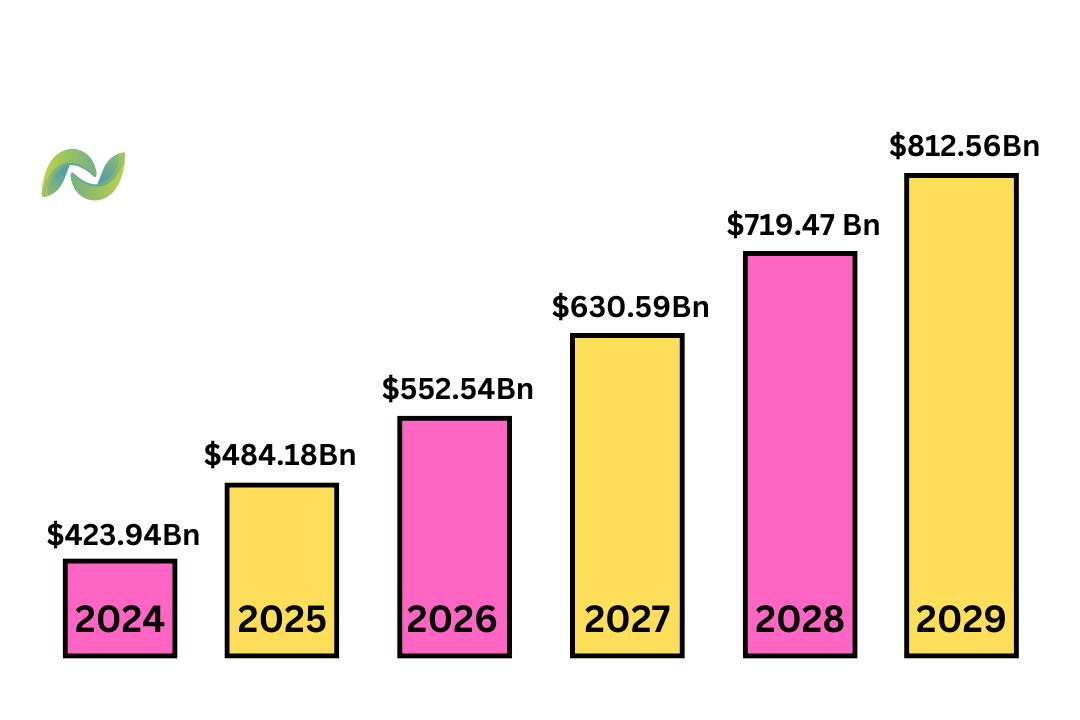
According to a report by The Business Research Company, the market cap of the travel industry in 2025 is $484.18 billion, and with a CAGR of 14.2%, the industry is expected to reach $812.56 billion in 2029.
Types of Travel Applications With Development Costs
[1] Flight and Hotel Booking Apps
Flight and hotel booking applications allow users to search, compare, review, and book their flight tickets and hotel rooms in advance easily. These apps are similar to agents but in digital form, hence making booking easy and convenient. These apps have features such as real-time booking, payment gateway integration, and user reviews etc.
Cost to Develop: $20,000 to $80,000.
[2] Travel Itinerary Apps
These applications help users easily organize their travel plans by combining flight schedules, accommodation details, and activities into a single unified itinerary. These apps include various features such as calendar syncing, offline access, and multi-device functionality etc.
Cost to Develop: $40,000 to $70,000.
[3] Navigation and Maps Apps
Navigation is one of the most essential types of travel apps. These apps offer turn-by-turn navigation, offline maps, and travel recommendations to the user. These apps have essential features such as AR navigation, traffic updates, and custom map overlays etc.
Cost to Develop: $50,000 to $110,000.
[4] Ride-Booking and Local Transport Apps
Ride booking apps such as Uber and Ola offer a seamless ride booking facility to users to book a ride and travel anywhere they want. They have features like live GPS tracking, multi-city support, in-app chats, fare estimation, and multiple payment options etc.
Cost to Develop: $50,000 to $120,000.
[5] Adventure and Activity Apps
As the same suggests, adventure and activity apps help the users book tours, activities, and experiences along with various activities such as trekking, rafting, bungee jumping, etc. These applications have essential features such as event scheduling, location-based recommendations, and secure payments etc.
Cost to Develop: $30,000 to $90,000.
[6] Language Translation Apps
Language translation applications are pretty straightforward. These apps help users to communicate in a foreign place using voice or text messages. Features include offline translation, camera text recognition, and real-time audio translation, etc.
Cost to Develop: $30,000 to $60,000.
[7] Travel Review and Community Apps
These apps provide reviews, tips, and recommendations from different travellers of a particular place, flight, hotel, activity, or experience. These apps have different features such as user-generated content, forums, and location-based services.
Cost to Develop: $20,000 to $50,000.
Essential Features of Travel Apps With Cost
[1] User-Friendly Interface: $350 to $1,000
[2] One-Tap Bookings: $600 to $1,500
[3] Real-Time Updates: $900 to $1,400
[4] Easy Itinerary Management: $350 to $900
[5] Offline Access to the App: $500 to $1,700.
[6] Language Translation and Currency Conversion: $450 to $1,400
[7] Rating, Reviews, and Recommendations: $480 to $1,300
[8] Loyalty Programs and Rewards: $600 to $2,000
[9] AI Chatbot and Customer Support: $1,000 to $3,000
[10] Security Features: $1,200 to $3,600
Various Panels of Travel Applications
[1] User-Side Panel
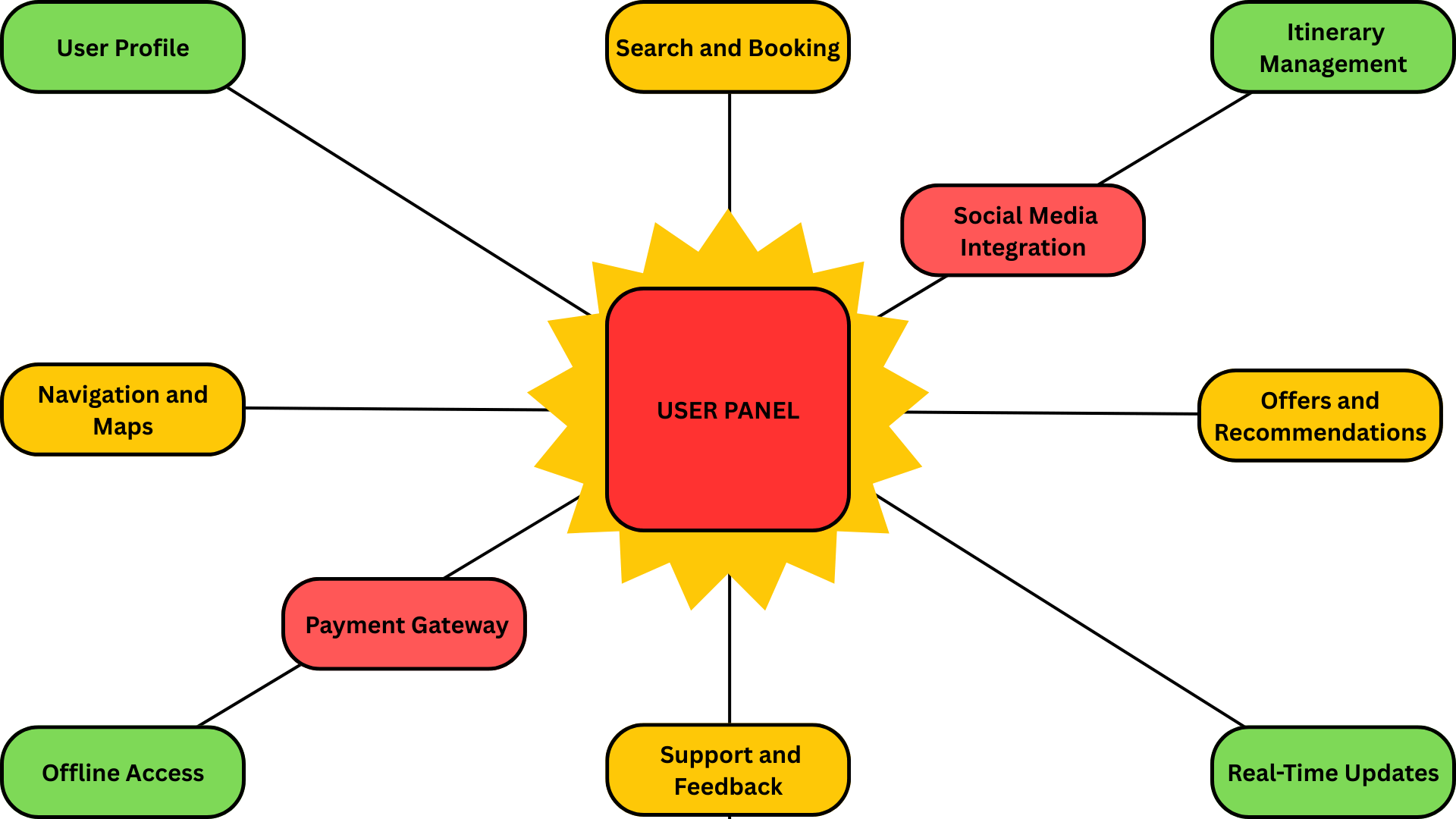
This panel is meant for the users of the app. It is the part that is visible to the users. It has many features such as:
User Profile: Create and manage the user profile, such as name, contact number, etc.
Search and Booking: Search and book hotels and flights, or trains to your preferred destination
Itinerary Management: Organize bookings into a trip schedule. Users can also add custom notes or activities to the itinerary.
Offers and Recommendations: Explore offers such as discounts and get recommendations as per your preference.
Real-Time Updates: Get real-time updates for light changes, delays, or cancellations, as well as weather updates, etc.
Support and Feedback: Get 24/7 customer support for any queries and issues, and provide feedback.
Offline Access: Get access to your saved bookings, maps, and itineraries without internet.
Navigation and Maps: Built-in maps and navigation features to get directions to any place.
Payment Gateway: Secure payment processing with multiple payment options.
Social Media Integration: Share your trips and photos with your friends and family on social media. Also, connect with other travelers.
[2] Vendor Partner Panel

This panel is meant to be used by service providers such as hotels, trains, airlines, buses, and tour agencies. etc. It has several different features, such as :
Profile Management: Create and manage a business profile like name, web app, email, etc.
Listing Management: Create, edit, and manage listings for services such as hotels, tours, activities, etc.
Booking Management: Manage the upcoming, confirmed, and past bookings of the customers and options to reject, accept, or modify the reservations.
Revenue Tracking: Easily monitor the earnings, status of payments, and past bookings.
Updates Regarding Availability: Update the availability status of the services in real time.
Offers and Promotions: Create offers, discounts, and promotions for the customers on the services.
Customer Interactions: Handle feedback and respond to the customer’s queries and issues.
Analytics and Insights: Get detailed insights on the bookings, revenue, profit, loss, user behavior, latest trends, etc.
Push Notifications: Get the latest alerts for the new or cancelled bookings and any other changes.
Training and Support: Access to the FAQs and other vendor-specific help centers and tutorials.
[3] Admin Panel
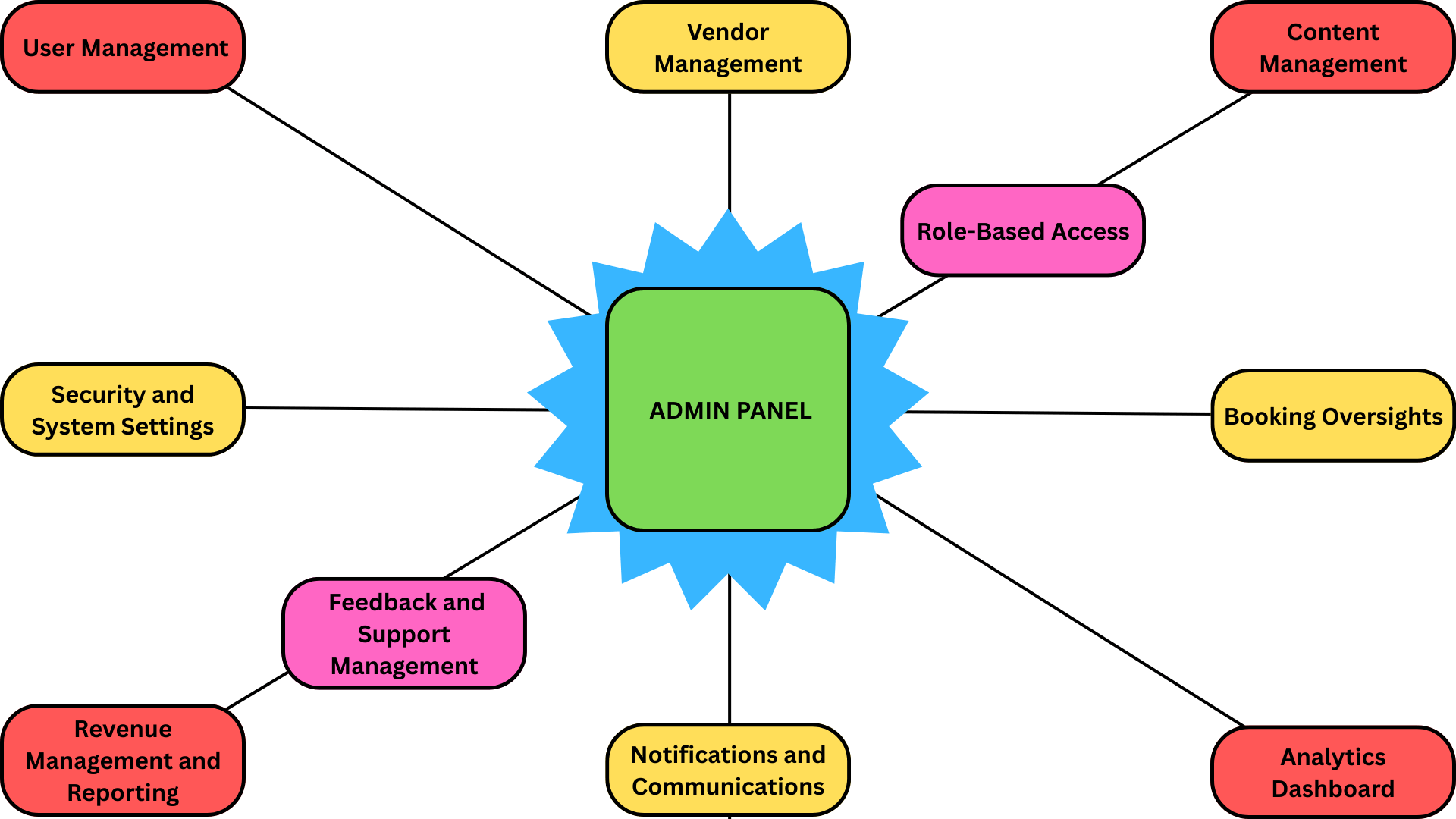
The admin panel has many features and functionalities to oversee the whole application. Some of the essential features are:
User Management: Easily view, edit, and delete user accounts and monitor user activities, bookings, and feedback.
Vendor Management: Manage the vendor listings and service quality. Approve or reject the vendor registrations.
Content Management: Manage promotional banners, discounts, and offers. Add, update, or remove app content like blogs, FAQs, etc.
Booking Oversights: Handle all cancellations, refunds, and user issues, as well as View and manage all user bookings.
Analytics Dashboard: Display real-time insights into app usage, revenue, and trends in the form of visuals.
Notifications and Communications: Easily send notifications, reminders, or promotional messages to registered users and vendors.
Revenue Management and Reporting: Create reports on bookings, earnings, and vendor payouts.
Security and System Settings: Manage the travel app settings, update policies, ensure legal compliance, and implement security features.
Feedback and Support Management: Analyze feedback to improve app features and services, and respond to user queries.
Role-Based Access: Assign specific permissions to sub-admins or team members based on their roles.
Factors Influencing Travel App Development Costs
[1] Features and Functionalities
Every travel app has various types of features and functionalities that help the user perform various tasks. The more features, the higher the travel mobile app development costs.
[2] Design Complexity
Design is what gives a unique identity to the mobile application. A visually attractive UI/UX design, Custom animations, interactive interfaces, and seamless navigation enhance user experience but also require significant cost.
[3] Platform Choice
Development of the travel app individually for each platform separately, such as Android and iOS, would cost much higher. Instead, you can opt for cross-platform solutions that cost less than native apps.
[4] Development Team
You can select a local team, hire freelancers, or outsource your project to a travel app development company. Local teams would cost less, and freelancers even less, but outsourcing to a company would increase the cost, but deliver a more professionally crafted application.
[5] Backend Development
The cost of backend development is backed by several factors such as technology stack, database, security level, etc
[6] Third-Party Services
Third-party integration, such as payment gateway API, maps API, weather APIs, and other tools and integrations, requires licensing or subscription fees, which add up to the cost.
[7] Testing and Quality Assurance
Testing is done to ensure a bug-free, user-friendly app, but it requires time and investment. Comprehensive QA processes add to development costs but are necessary for long-term success.
[8] Maintenance
To ensure the travel app keeps running for a long time, it requires regular maintenance and updates. Adding new features, bug fixes, and compatibility checks with new devices or platforms are continuous costs.
[9] Development Team Location
The travel app development cost also depends on the location of the development team. A team in the USA would charge more than a team in Malaysia or Australia.
[10] Marketing and Promotion
Every app requires powerful marketing campaigns to boost its presence and help it reach a wider audience. Marketing is a continuous process and requires a significant amount.
Travel App Development Process with Cost Estimates
Stage 1: Project Defining and Requirement Gathering
This is the foundation stage of your project. In this stage, the project idea is analyzed by professionals, and several feasibility assessments are conducted. After the feasibility test is done, the requirements of the project are discussed, and an SRS document stating the requirements is made and signed by the client.
Cost Estimate: $1,000 to $1,500.
Stage 2: Project Planning and Discussion
In this stage, the development and design team gather and review the SRS thoroughly. Then, a robust plan is made that includes the selection of a technology stack, development methodology, project timeline, milestones, and other resources needed.
Cost Estimate: $2,000 to $5,000.
Stage 3: Designing and Prototyping
In the third stage, there are several activities performed, such as creating wireframes, user interface (UI), and user experience (UX) designs. Working prototypes of the proposed application help visualize the app’s flow.
Cost Estimate: $5,000 to $10,000.
Stage 4: Travel App Development
This is the main stage. The full-scale development of the app begins. The frontend and backend are further divided into smaller modules and developed separately using the selected tech stack and integrating features like booking systems, maps, and user profiles, etc.
Estimated Cost: $13,000 to $50,000 or more.
Stage 5: QA Testing and Debugging
After the development is over, it is time to test the app. Testing ensures smooth functionality across devices. This step includes fixing errors and optimizing performance, and checking the compatibility across different platforms and devices.
Cost Estimate: $4,000 to $12,000.
Stage 6: Deployment and Launch
After testing, the app is deployed to the respective platform (Android or iOS). The deployment is followed by extensive marketing campaigns.
Cost Estimate: $3,000 to $6,000.
Stage 7: Maintenance and Support
The maintenance is crucial for updates, troubleshooting, and ensuring compatibility with new OS versions.
Cost Estimate: $1,000 to $5,000 Per Month.
Tech Stack for Travel App Development
[1] Frontend: Java, Swift, Kotlin, Objective-C, Flutter, React Native, Dart, Ionic
[2] Backends: Java, Python, Node.js, Django, Ruby on Rails
[3] Web Servers: Apache, Nginx
[4] API: REST, GraphQL, SOAP
[5] Database: MySQL, PostgreSQL, MongoDB, NoSQL
[6] Mapping API: Mapbox, Google Maps Platform, Apple Maps
[7] Geolocation Services: Core Location for iOS, Location Services for Android
[8] Payment Gateway API: PayPal, Stripe, Razorpay
[9] Cloud: AWS, Azure, GCP
[10] Analytics: Google Analytics, Firebase Analytics, Crashlytics
Various Monetization Models for Travel Apps
[1] Commission-Based Model
In this model, the travel app gets a small amount from every booking that happens through the app. For example, when users book flights, hotels, or activities through your app, you earn a percentage of the transaction amount.
[2] Subscription Model
In this model, the app user pays a recurring fee, either monthly or yearly, for premium features. The features can be exclusive deals, personalized itineraries, or ad-free usage.
[3] Advertising Model
Travel apps can allow advertisements to run on their platform. The advertisers will pay the platform fees for advertising their services and products.
[4] Freemium Model
In the freemium model, users get a basic version of the app and pay for more exclusive features. For example, basic travel planning might be free, but users pay for features like offline access or personalized recommendations.
[7] In-App Purchases
This is one of the most widely adopted strategies used in mobile applications. The users can pay an additional amount to purchase digital assets within the app, such as digital guides, exclusive maps, or premium trip planners.
Tips to Optimize Travel App Development Costs
[1] Define Clear Goals and Requirements
It is better to define clear goals and requirements at the start of the travel app development project by identifying the essential features your app needs, such as search functionality, booking systems, real-time updates, and user profiles.
[2] Choose the Right Development Approach
Select the right development approach that suits your project goals. An Agile development approach is recommended as it allows for iterative improvements of the app. Also, consider cross-platform development over native app development to reduce costs.
[3] Leverage Open-Source Tools and APIs
Many open-source tools and APIs, such as geolocation, payment gateways, and travel updates, are freely available so consider incorporating them into your project.
[4] Outsource Development Wisely
Choose the right development team that suits your project goals and overall budget. Select the team in a country where the operations and development costs are low.
[5] Focus on MVP Development
A minimum viable product is a prototype of the proposed application that includes the core features and functionalities. An MVP app allows the developers to make early changes before commencing any major development.
[6] Cloud-Based Infrastructure
Cloud platforms work on a subscription-based model, and you can select the best plan that matches your project goals and budget.
How to Select A Travel App Development Company in 2025?
Selecting a travel app development company in 2025 is important to ensure your app project idea transforms into reality. Look for their portfolios, ensure they offer timely project delivery, and have a client-focused approach with open communication. One such company is Next Olive, which has over 13 years of experience in travel mobile application development and offers their travel app development services in over 20 countries. They are experienced in working with the latest technologies, such as AI/ML, Blockchain, IoT, etc.
Conclusion
In conclusion, the cost of travel app development depends upon many factors, such as type, platform, selection of tech stack, features, and more. There are multiple types of travel apps you can choose from. Moreover, the selection of a travel mobile application development company is also very important. This guide covered all the major aspects of travel application development.
Frequently asked questions (FAQs)
The cost of various travel applications is as follows:
- On-Demand Hotel Booking App Development Cost: $10,000 to $200,000.
- Tourism App Development Cost: $10,000 to $80,000.
- Custom Flight Booking App Development Cost: $15,000 to $70,000.
- Bus Booking App Development Cost: $10,000 to $50,000.
The cost can vary according to the added features and functionalities.
The time required for travel app development depends upon several factors such as type, size, complexity, etc. Generally, it takes between 2 to 3 months for a basic app, 3 to 7 months for a medium-complexity app, and 7 to over 12 months for a highly complex app.

